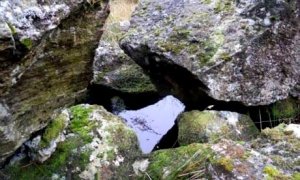Water Deities haven’t lost their power over us .
Along the Dee Valley this is especially true , one of the goddesses strongly associated with the River Dee is Aerfen who is said to have had a shrine or grove near Glyndyfrdwy . The River Dee was occasionally known as Aerfen in Middle Welsh. Today nothing remains to indicate where or what this shrine was . It’s reasonable to suggest that the shrine was a ‘grove’ on the bank of the river or in a wooded area near it .
If Aeron , as some have suggested is a version of name Aeron the war goddess which derives from from Agrona a Goddess of Slaughter then the link to war and sacrifice is more easily explained
Ian Pegler in his work Valle Crucis and the Sunline suggests that Aefen’s shrine was near to the sunline and this is of symbolic significance for the location of the ‘shrine’
On a recent walk along the Dee we pondered where this grove or shrine had been located and had it existed outside local folklore and legends ? Many photographs were taken along the way . Much to our surprise one of the images provided a surprise ! In the right hand corner of the image below a shadow of red can be seen in the water – as Aerfen is associated with war and sacrifice this seemed very appropriate . Camera error – yes most likely but it added some excitement to the adventure .
Very little is known or written about Aerfen .Dyfrdwy refers to the river Dee and is interpreted as waters of the goddess but which goddess isn’t clear as many deities may have been worshipped along the course of the river which is approximately 70 miles (110 km) from it’s source at Dduallt to the estuary at Flint
The present-day River Dee has its source on the slopes of Dduallt (ðɨæɬt – “Black Hill”) 662m above Llanuwchllyn in the mountains of Snowdonia
Aerfen has also been said to reside near the source of her river and mention has been made of a structure built over one of the pools . This hasn’t been verified as yet and a visit to the site is planned in the near future
At Llanuwchllyn the Dee is joined by the Lliw and the Twrch meaning boar .
William Camden wrote:
The river Dee, called in Latin Dava , in British Dyfyr-dwy , that is, the water of Dwy , breeding very great plenty of Salmons, ariseth out of two fountaines in Wales, and thereof men thinke it tooke the name. For dwy in their tongue signifieth two. Yet others, observing also the signification of the word, interpret it Blac-water , others againe Gods water or divine water. But although Ausonius noteth that a Spring hallowed to the Gods was named Diuvona in the ancient Gaules tongue (which was all one with the British), and in old time all rivers were reputed Διοπετεῖς, that is, Descended from Heaven ,
yea and our Britans yeelded divine honour unto rivers, as Gildas writeth, yet I see not why they should attribute Divinitie to this river Dwy above all others.







Reblogged this on Cymraes's Corner and commented:
As you will know, Dear Reader, the Romans equated Minerva with this Goddess and built a shrine to her on the banks of the Dee at Deva/Chester which is still in-situ … and visited by your’s truly on a regular basis.
Hence this re-bogged post is very valuable info; I having traced the Dee to her source, as well as the quaint folk lore that her waters didn’t mingle with those of Llyn Tepid/Bala Lake, but flowed straight through, remaining pure (and untainted?) on course for the estuary at the Wirral.
LikeLike
Why do we continue to use the colonial name “dee” and not the beautiful and more importantly meaningly name “dyfrdwy”……who was a Celtic Water Goddess according to mythology……we bury this knowledge everything we prioritise the Norman English corruption names surely?
Yours, A northamptonshire boy with a love of real British Celtic culture
LikeLike
Sorry typos
Everything should be Everytime
and Meaningly should be ‘meaningful’
LikeLike